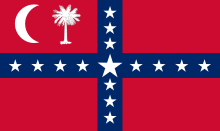Flag of South Carolina

The Flag of the State of South Carolina ( known as "Moultrie's Flag" , named in honour of General William Moultrie, following the Spectacular Victory against the British in the Battle of Sullivan's Island, later renamed Fort Moultrie ).
It dates back to 1765 when opponents of the Stamp Act marched in protest behind a blue flag bearing three white crescents. In 1775 Colonel William Moultrie was asked by the Revolutionary Council of Safety to design a flag for the South Carolina troops to use during the American Revolutionary War. Moutrie's design had the blue of the militia's uniforms and the crescent from the emblem on their caps. The palmetto tree was added in 1861 to honor Moultrie's heroic and ingenious defense of the palmetto log fort on Sullivan's Island against the attack of the British fleet on June 28, 1776. South Carolina's flag was ranked as the 10th best designed state or provincial flag in North America by the North American Vexillological Association in 2001.[1]
History




After considering many designs for the Republic of South Carolina flag, it was decided that the existing State flag with the crescent and blue background could be modified for a National flag. On January 26, 1861, the South Carolina General Assembly adopted a new flag by adding a golden palmetto tree encircled with a white background. However, this flag has become known as the "2-day flag" because the golden palmetto tree was changed on January 28 to a simple white palmetto tree on the blue background.[2]
The palmetto tree represents the palmetto logs used to construct the fort on Sullivan's Island. These logs do not have rings, so the cannonballs that the British fleet fired on the fort did not break through. On June 28, 1776, Colonel William Moultrie and his troops were able to successfully defend Charleston using this fort, and the fort would be named Fort Moultrie in honor of this defense.
As for the crescent, it is known to have been worn on the caps of South Carolina's revolutionary soldiers. However, its significance is based more on legend than on documented facts. One hypothesis is that it stems from the crescent as the cadence mark of a second son. It is true that many of the early colonists were second (and third, etc.) sons who had no inheritance in England and came to America to find their fortunes. Their coats of arms would have crescents to distinguish themselves from the first sons; and thus, perhaps the crescent was adopted as a symbol for the colony. An alternative hypothesis is that the crescent may be derived from the crescent on the coat of arms of the Bull family, which was prominent in the early days of the colony and produced one of Charleston's more illustrious Royal Governors.[3]
The Sovereignty/Secession flag was never recognized as an official flag in South Carolina. However, it was flown all over the Union during the American Civil War as a show of support for the South. There are also claims that it was flown for a short period of time in South Carolina after its secession on December 20, 1860.
Interestingly, the National flag of the Republic of South Carolina remains to this day as the State flag of the State of South Carolina.
Commercial use
Shirts, belts, shoes, wallets, and other accessories featuring the flag's palmetto tree and crescent are popular throughout South Carolina and other southeastern states as a symbol of the state's long-standing heritage. It is also customary for alumni and supporters of the state's main universities (the University of South Carolina, Clemson University and The Citadel) to display the state flag in their school colors.
See also
- Gallery of flags with crescents
- State of South Carolina
- Symbols of the State of South Carolina
- Great Seal of the State of South Carolina
